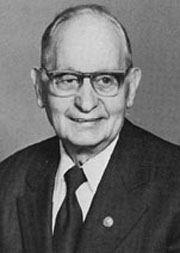Waino Hendrickson
Waino Hendrickson: A man of the people
This profile of Waino Hendrickson appeared in the April 10, 1998 Whalesong. By Eileen Wagner

"There just ought to be a lot more people like him," said a longtime neighbor of Waino
Hendrickson. Don Burford lived a block away from the Hendrickson house on "C" Street
and remembers him as "very understated, very decent, never very presumptuous. He gave
a lot more than he took."
Waino Hendrickson's life parallels a good portion of the last hundred years of Juneau's
history. Born here in 1896, he was the second child of Finnish immigrants. His father
was a miner at the AJ Mine, and his mother ran a 20-room boarding house for miners.
The Rocklin House, as it was called, stood where the Baranof Hotel now stands.
In 1916, Waino (or Vaino, as it was pronounced) graduated from Juneau High School
and went to work at the mine. An accident caused him to lose partial sight in one
eye. In 1918 he enlisted in the army, and was on his way to France when the Armistice
was signed. Upon his return to Juneau, he went to work at the City Dock as assistant
wharfinger, or manager.

In 1924, he married Marion Kingsnorth Jones, a nurse from Victoria, B.C. who worked at St. Ann's Hospital. A few years later, he began to work for Alaska Laundry. He became part owner of the business and continued there for 20 years.
Later in his life, Hendrickson was quoted as saying that delivering laundry and making collections taught him a lot: "You'd be surprised how much you learn about people when you have to keep after them on back due accounts."
Robert Thibodeau thinks the job was probably responsible for his becoming mayor. Hendrickson was encouraged to run for mayor in 1946. "He had contact with a lot of different people," Thibodeau said. "He never offended anyone. He was one to smooth things over and avoid confrontation." Former councilman and mayor Wayne Johnson said simply, "People wanted him to run because he was a good man." He served as mayor until 1953.
Next-door neighbor Mike Grummett remembers Hendrickson driving him and his brother to church on Sunday in the back of the delivery van. When Grummett visited Hendrickson in the city council chambers, he remembers being impressed that mild-mannered Waino Hendrickson who drove him to church also held the highest office in town and had such a big table to work at.

Larry Parker said that Hendrickson's most important work as mayor was getting the city power to levy and use sales tax. There was no sales tax prior to this, and in the days before oil money, cities had virtually no way to raise funds.
Parker, who continues to this day as the power behind the Fourth of July fireworks display, credits Hendrickson with getting the Fourth started as the big celebration that it is in Juneau. "Waino was in the American Legion. He was behind it all—the parades, the fireworks—he knew where to go to get the money for the Fourth of July."
Apparently, Waino also knew how to make arrangements for the weather during the Fourth. "When he was running for mayor of Juneau, he promised there would always be good weather for the parade," said David Forrest, a grandson of Waino. "Of course, if you live in Juneau, you know there's usually good weather some time during the day. Every year, if it's sunny on parade day, we thank Waino for keeping his promise."
Wayne Johnson recalled that Hendrickson got a sales tax passed to pave the streets, and Juneau thus became the first city in Alaska that was fully paved.
Hendrickson also served in the Territorial House of Representatives from 1948 to 1953. In 1953, he was named by President Eisenhower to be Secretary of State under Territorial Governor Frank Heintzleman, and served in this position until statehood. During this time, he served as Acting Governor twice.
He was appointed first chairman of the Interior Department's Alaska Field Committee, and then director of the Juneau office of the Bureau of Land Management. Mike Grummett remembers that the lights in Hendrickson's house were apt to be on late at night or early in the morning as he cared for his wife who was ill with cancer. She died in 1962, and after his retirement in 1965, Hendrickson moved to Anchorage to live with his daughter.
He continued to serve on several statewide committees for a few years until his eyesight became worse. He died in 1983, and is buried in Evergreen Cemetery.
The plaque on the side of the building named in his honor reads as follows: "This building is named in honor of Waino Hendrickson, a true Alaska pioneer whose lifetime of service to the community and state serves as a model of honesty and dedication."
Waino Hendrickson is also mentioned in this article:
UA Honorary Degree 1976
